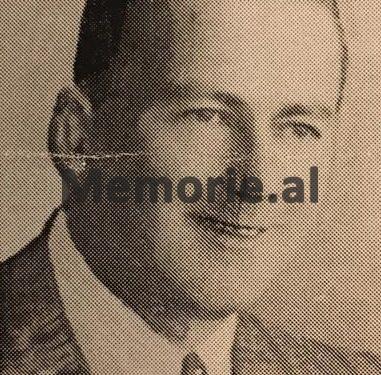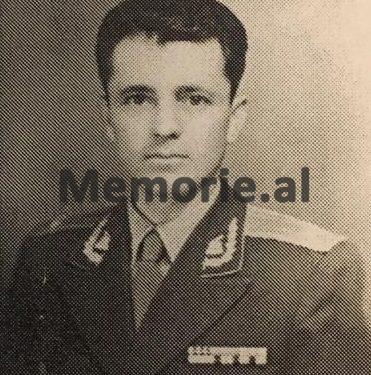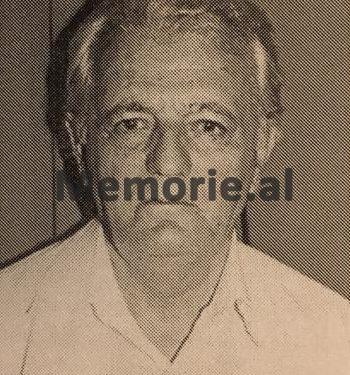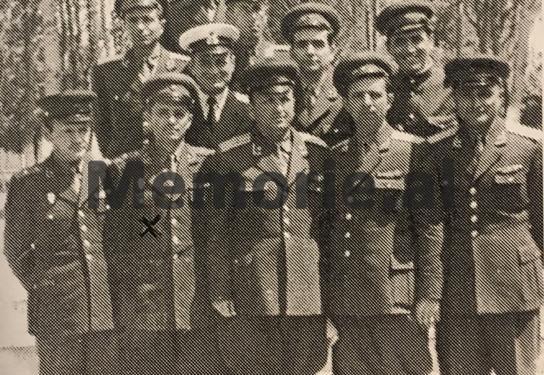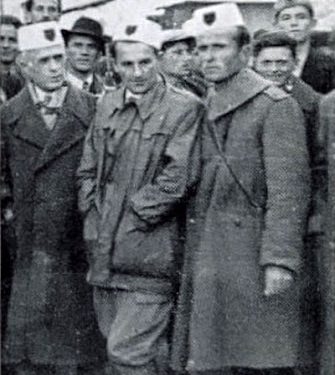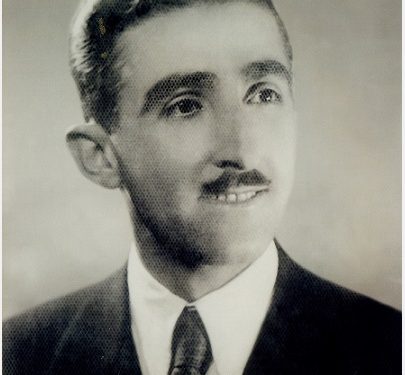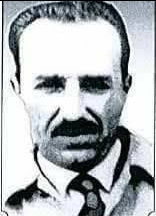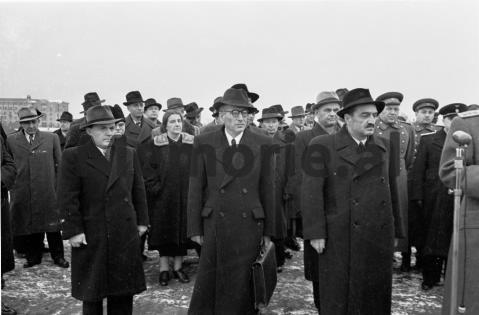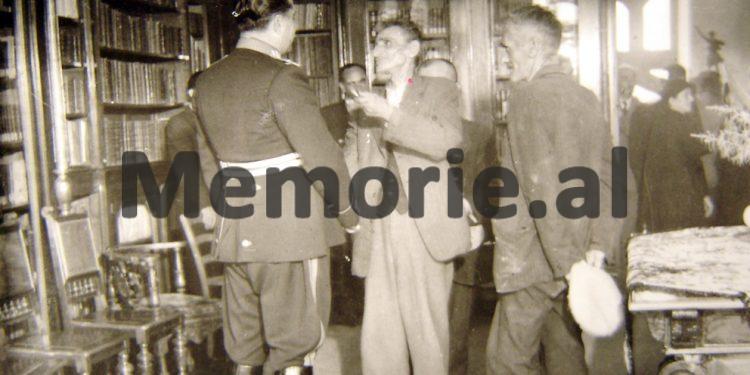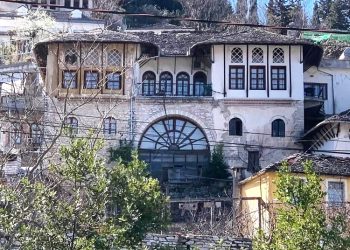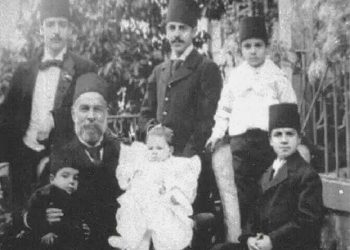Dashnor Kaloçi
Memorie.al publishes the unknown history of the event that took place in the city of Vlora on October 7, 1943, when after the directives coming from the Albanian Communist Party headed by Enver Hoxha, the Communist District of Vlora, headed by Mihal Prifti and the commander of guerrilla units of that city, Rr. P. decided to assassinate Haziz Sharra, who was the leader of the nationalist youth of Balli Kombëtar. The rare testimony of Colonel Istref Mustafaraj, former Artillery Commander for several large military units in Vlora, Durres, and Saranda, who was one of the three assassins charged by the Communist Circle of Vlora, and together with two comrades His, Miço Emini from Vlora and Jonuz Peja from Kosovo, ambushed Haziziz near his house at “Flag Square” and as he was heading towards the “Muradije” Neighborhood, the three-shot him with their revolvers. , hitting him with seven bullets in the body, but from the strong physique he had, he did not fall to the ground, but pulled out his “Nagant” and, shooting in their direction, chased them for about 100 meters and wounded two of them. Haziz’s sending to his home by friends who came quickly to the scene after the assassination attempt and the prayer they made to Dr. Kaçalino for treating him and his refusal as he feared he would be killed by the Communists when they learned that he had treated one of the main leaders of the Vlora National Front. How Haziz’s friends, members of the Vlora National Front, then retaliated by killing the two assassins, Miço Emini and Jonuz Peja, and then Dr. Kaçalino, the doctor who had refused to treat Haziz Sharra, but had treated his assassin, Jonuz Peja, at Bule Imami’s house. The rare story that took place in the city of Vlora, where the chain of murders between communists and ballists continued, as the communists also killed Marie Qazimi, Thoma Arapi, and later Qamil bey Risilina, who was an anti-communist.
“On the morning of October 6, 1943, my friend Miço Emini, gave me a letter written by the secretary of the communist district of Vlora, Mihal Prifti and the commander of the guerrilla unit of the city Rr. P., who ordered me, Elham Doçi and Jonuz Peja, to assassinate Hazis Sharra, who at the time was one of the main youth leaders of the Balli Kombëtar in the Vlora district. The next day, together with my two comrades in the unit, I ambushed Haziz, who in the morning left his house near Flag Square and headed for Muradie Street. After letting him pass, Jonuzi and Elham and I shot him three times, and seven bullets from our revolvers hit him in the body, but Haziz, who was very powerful, did not fall to the ground, and so with bullets in the body, he pulled out the Nagant and, firing at us, followed us for about 100 m. ” This is how Colonel Istref Mustafaraj, former commander of the Artillery in Sazan, Vlora, Saranda, and Durrës, who recounts one of the most sensational events of the war period, recalled the event of the assassination attempt on Hazis Sharra in early October 1943. when he and his comrades of the guerrilla unit assassinated one of the main exponents of the nationalist youth of Vlora, an event which at that time became the cause of the launch of a long series of assassinations, where there were many casualties from the communists, as well as by nationalists. Who is Istref Mustafaraj, what is his past, and how was the murder of Haziz Sharra carried out? Who were the people who ordered that murder, where did the meeting take place and why was it decided to kill Haziz Sharra instead of Kudret Kokoshi? Where were the three assassins sheltered after the action and how were two of them killed in retaliation by Balli’s forces and how did the series of killings on both sides continue?
The plan to kill Sharra
How was the plan to assassinate Haziz Sharra made and who were the people who ordered that assassination attempt? Regarding this, Istref Mustafaraj said: “After the capitulation of fascist Italy, the orientations that came to the Vlora Region by Enver Hoxha, were no longer of a theoretical plan, but at that time according to the decisions of the Albanian Communist Party,” Shpati “brought constantly letters, where he ordered the killing of concrete persons. In the framework of these orders sent by Enver Hoxha at that time, at the beginning of October 1943, the representatives of the Communist District of Vlora, gathered at the house of Bule Imami, which was located in the neighborhood “Topana”. There was a long debate over whether to kill Kudret Kokoshi, who was a member of the Balli District, or Haziz Sharra, who was a representative of the Balli Youth. After much discussion, those who supported the assassination of Haziz Sharra won, arguing that if Kudret Kokoshi was killed, Hazizi as a shareholder would retaliate, killing the main leaders of the Communist District, and if Hazizi, Kudreti, were killed. many would write some poems as the man of the pen who was. The decision to assassinate Haziz was made just two weeks after Communist Party representatives Hito Çako and Burhan Beqari visited Kudret’s house to ask for an agreement on the distribution of trophies. captured the Italians after the capitulation, an agreement that was realized. After the decision to kill Haziz Sharra, the commander of the Vlora guerrilla unit, Rr. P. and the Secretary of the Communist District, Mihal Prifti, issued a written order to carry out the action, assigning us to implement it as assassins: me (Istref Mustafaraj) Elham Doçi from Vlora and Jonuz Peja from Kosovo, who were members of the unit guerrilla of the city “, Istrefi recalled, the decision for the murder of Haziz Sharra, who was taken by the Vlora District, after the orders sent by Enver Hoxha from Tirana.
Assassination of Sharra
How was the assassination of Haziz Sharra carried out and how did the events unfold after that murder? Istrefi testified about this: “According to the decision of the District and the guerrilla unit, the written order for the murder of Haziz Sharra signed by Mihal Prifti (prof. In the Commercial School of Vlora) and Rr. P. was handed over to me by our friend Miço Emini, on the morning of October 6, 1943. After getting acquainted with the order to kill Haziz Sharra, whom I had known since April 1939, when together with Mitaq Sallata, Azbi Tepelena, Nuri Arapin, etc., we had gone to look for weapons to fight in Bestrova, we started thinking only about carrying it out, because to discuss that order, there was no question. At that time, in the practice of the guerrilla unit, when an assassination attempt or action was charged, you should by no means seek explanations, but only apply it to be charged. So after receiving the order to carry out the assassination attempt, on the morning of October 7, 1943, I, together with my two friends, Elham Doçi and Jonuz Peja, supported by three or four members of the unit, ambushed Haziz Sharra, who after leaving his house near Flag Square, he set off in the direction of Muradie Street (now Museum Street). Knowing that Haziz was a brave and very strong boy, where everyone was trying to avoid clashes with him, we also thought that we would not face him and after letting him pass, we would shoot him from behind. So we did. After Hazizi continued walking towards Muradie Street, we shot three and seven bullets at the same time and our revolvers caught him in the body. But since he was a great physicist, he did not fall to the ground and pulled out the “Nagant” and following him for about 100 m., He started firing in our direction, injuring me and Jonuz, who ran home. of Bule Imam, where the main comrades of the unit were waiting for us, to report on the conduct of the action. After we quickly disappeared from the scene, Haziz was picked up by some bystanders, who sent him to his nearby home. After that, two of his friends, who were immediately there, immediately went in search of a doctor, and the first person they met was Dr. Kaçalino, (from Vlora), who after being told what had happened, was asked to go with them to treat Haziz. Dr. Kachalino, who was a very good man and had never been involved in politics, refused to go and treat Haziz, telling them that the partisans would find out and kill him as well. While Dr. Kaçalino refused to treat Haziz who died that night at his home from seven wounds on his body, he went to Bule Imam’s house and treated my friend Jonuz Peja, and I was treated at a butcher’s house, but in that neighborhood. The assassination of Haziz Sharra was not the first action I took part in, because at the end of June 1943, Miço Emini and I arrested Thoma Arapi and Marie Qazimi, who was later shot. Later, after the capitulation of Italy, I took part in the action of stealing gold in the Bank of Vlora, where Nuri Arapi commanded us and at the end of September 1943, our unit commanded by Burhan Beqari killed Qamil Bey Risilina, who was a rabid anti-communist, ”recalled Istref Mustafaraj, in connection with the assassination of Haziz Sharra and other actions in which he took part during the war.
The murder of Dr. Kaçulinos and assassins
How did the events unfold after the murder of Haziz Sharra and how did the series of assassinations that brought many victims from both the communists and the National Front continue? Regarding this, Istrefi testified: “After the members of the Balli Kombëtar forces found out that Dr. Kaçalino had gone and treated Jonuz Peja at Bule Imam’s house, they killed the doctor in revenge, as he had refused to treat Haziz Sharra, a murder which at the time was condemned by almost all Vlora residents. On October 20, 1943, together with some young people, we gathered on Narta at the “Jewish Stone” where, by order of the District, we were informed that we would be admitted to the party. Elham Doçi and Jonuz Peja and I were surprised because we called ourselves communists because, since May 1942, I had organized and directed the communist youth of the neighborhood where I lived. When we asked him why we were not called communists, Dhimitër Mandro told us: ‘Now that you have killed Kuçedra (it was about Haziz), you have given evidence and you will be accepted as communists’. Accepting the party as a communist was a great joy for us, but my two friends, Jonuzi and Elham, were not happy, because two days later, on October 22, 1943, they were assassinated in front of the Municipality of Vlora, where today it is the Ethnographic Museum. The assassination attempt on them was carried out by two young men of the National Front, A. S. and R. R., in revenge for the assassination attempt on Haziz Sharra. Shortly before the murder of Jonuz and Elham, the ballists had killed Two other partisans, HB and LL, were also killed. In retaliation for the killings of Jonuz Peja and Elham Doçi, the partisans carried out an operation in Qafë i Bestrovës in those days, arresting about 30 Topalli villagers, who sent them to “The Jewish Stone on Narta, where after shooting five of them, the others released them,” concluded his confession, Colonel Istref Mustafaraj, who during the war was one of the assassins of the guerrilla unit of Vlora, who committed the murder of Haziz Sharra. But after the 1990s, what was the attitude of the Sharra family towards Istref Mustafaraj? In this regard, Shpetimi Sharra (Muharrem’s son, Haziz’s brother) states: to our family, whom I did not want to see with my own eyes. But justifying that man by his testimony denouncing himself, for an act committed when he was quite young and imposed by the rules of the Communist Party, I hailed his attitude and considered the murder of his uncle a closed chapter “.
Who was Haziz Sharra?
Haziz Sharra was born in the city of Vlora in 1916, where the first members of his family had settled since 1800, after moving from Kavaja. Haziz’s father, Muço Sharra, who had been sentenced to death in 1908 by the Istanbul High Gate, along with Ibrahim Abdullah, Elmaz Xhaferri, Ali Beqiri, and Duro Shaska, came out openly in support of Ismail Qemali. In 1912, Muço Sharra, together with some other Vlora patriots, received Ismail Qemali at the Mifol Bridge and at that time the entire Sharra family, led by Hasan Sharra, supported Ismail Qemali since the days before the proclamation of Independence, took refuge in the house of Musa Sharra. During the Vlora War in 1920, Muço Sharra was the first to be exiled by the Italians on the island of Sazan, along with Jani Minga, Dom Mark Vasa, and many other patriots. During the years of the Zog Monarchy, the Sharra family did not interfere in politics, but their position was in support of King Zog. Being in a good economic situation, Hazizi, after attending classes in Vlora, went to study in “Zosimea” of Ioannina in Greece, where after completing two years, he returned to the city of Vlora, where he joined the Antifascist Movement. In late 1942, he became one of the leading leaders of the Balli Kombëtar Youth in the Vlora district and led that organization until October 1943, when he was assassinated by the Communists. At that time, in addition to Haziz, the nationalist organization Balli Kombëtar was joined by brothers Shyqëri and Lekmi Sharra, who was imprisoned and executed by the communists in 1947, as well as the famous engineer Abdyl Sharra, who was shot by the communist regime. , accused of being a “saboteur in the drying up of the Maliqi swamp”. Also after the end of the war, the Sharra family imprisoned Mendu, Astrit, and Muharrem Sharra (Haziz’s brother), and Ymer Sharra, who during the war had been prof. at the Vlora School of Commerce, he fled Albania and settled in the United States, where he worked for a long time at several universities, doing research. In 1946, the Sharra family in Vlora was left homeless and Muço Sharra (Haziz’s father) was sentenced to 12 years in prison at a young age when he was released from prison, leaving no other shelter. of the Elders of Fier where he died in complete misery./Memorie.al




